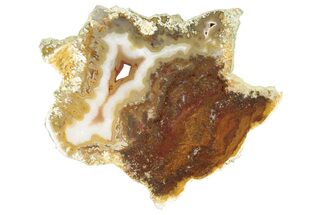This Specimen has been sold.
8.7" Polished Biggs Jasper Slab - Oregon
This is a gorgeous 8.7" wide slab of Biggs Jasper that was collected from Biggs Junction, Oregon. It features layer-like and twisted jasper formations that range in color from brown, tan to orange in spots. It comes with an acrylic display stand.
About Biggs Jasper
Biggs Jasper is a unique and highly sought-after variety of jasper first discovered near Biggs Junction, Oregon, around 1960, along the banks of the Columbia River. Formed millions of years ago, it started as volcanic ash that mixed with mineral-rich waters and subsequently solidified through the intense pressure and heat from volcanic activity. This transformative process turned the soft ash into a hardened, microcrystalline quartz, giving rise to the stunning, durable jasper we see today.
Renowned as a "picture jasper" Biggs Jasper is celebrated for its scenic, landscape-like patterns that resemble painted desert vistas, hills, and horizons. These patterns generally feature rich, earthy hues, including deep browns, soft beiges, creamy whites, and subtle grays. Some specimens also reveal darker, almost black lines that create striking contrasts, enhancing the stone's scenic appeal. The layering within Biggs Jasper often appears as flowing bands or striations, giving the impression of rolling landscapes or layered rock formations in a desert or canyon.
Biggs Jasper is a unique and highly sought-after variety of jasper first discovered near Biggs Junction, Oregon, around 1960, along the banks of the Columbia River. Formed millions of years ago, it started as volcanic ash that mixed with mineral-rich waters and subsequently solidified through the intense pressure and heat from volcanic activity. This transformative process turned the soft ash into a hardened, microcrystalline quartz, giving rise to the stunning, durable jasper we see today.
Renowned as a "picture jasper" Biggs Jasper is celebrated for its scenic, landscape-like patterns that resemble painted desert vistas, hills, and horizons. These patterns generally feature rich, earthy hues, including deep browns, soft beiges, creamy whites, and subtle grays. Some specimens also reveal darker, almost black lines that create striking contrasts, enhancing the stone's scenic appeal. The layering within Biggs Jasper often appears as flowing bands or striations, giving the impression of rolling landscapes or layered rock formations in a desert or canyon.
About Jasper
Jasper is a term that can be applied to an opaque variety of chalcedony. The opaqueness is due to a higher concentration of impurities mixed with silica/quartz compared to other varieties of silica, such as quartz or agates. Like agate it may form in a wide variety of colors, and is often multi-colored. In most cases, jasper forms when silica-rich fluids permeate throughout a soft sediment or volcanic debris deposit. The fluids then crystallize around the particles/impurities, resulting in a cementation process. Most often, the impurities present determine the coloration of the deposit following solidification, but other factors can play a role in the color of what is now considered a jasper.
Jasper is a term that can be applied to an opaque variety of chalcedony. The opaqueness is due to a higher concentration of impurities mixed with silica/quartz compared to other varieties of silica, such as quartz or agates. Like agate it may form in a wide variety of colors, and is often multi-colored. In most cases, jasper forms when silica-rich fluids permeate throughout a soft sediment or volcanic debris deposit. The fluids then crystallize around the particles/impurities, resulting in a cementation process. Most often, the impurities present determine the coloration of the deposit following solidification, but other factors can play a role in the color of what is now considered a jasper.
SPECIES
Chalcedony var. Jasper
LOCATION
Biggs Junction, Oregon
SIZE
8.7 x 8.2", .4" thick
CATEGORY
SUB CATEGORY
ITEM
#125684
 Reviews
Reviews













